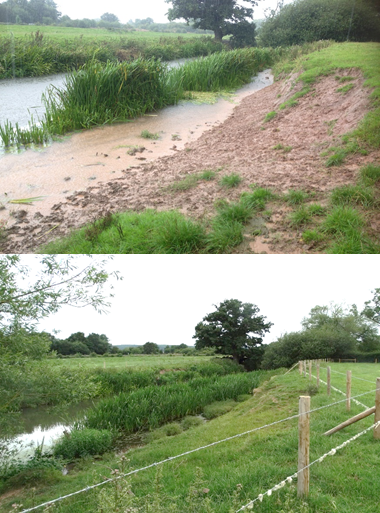Herefordshire’ rivers are facing declining wildlife populations, unprecedented algal blooms, flooding, and pollution levels. While perhaps sometimes overshadowed by the much-loved Wye Valley, Herefordshire’s River Lugg, a major tributary of the Wye is equally valuable for wildlife and deserving of our care and attention. Herefordshire Wildlife Trust manage over 130 hectares of the floodplain of the River Lugg, including iconic beauty spots Bodenham Lake and Lugg Meadows nature reserves. In 2015 we recognised that to tackle the issues of pollution and disconnected wildlife habitats in the floodplain of the River Lugg, we would have to extend the focus of our work beyond our nature reserves to the wider landscape. In the past seven years we have had an overwhelmingly positive response from the farming community, who have witnessed the decline in wildlife and rise in pollution levels in the River Lugg first hand. Whilst some farms continue to act as significant sources of pollution and habitat degradation, over 35 farms have undertaken a range of positive works which benefit not only farm productivity but also wildlife.
As the climate changes and rainfall increases, the floodplain of the river is facing more frequent flooding, which is lasting for longer. The impact of prolonged periods of flooding is devastating for farmers and for wildlife. Curlew numbers are at an all-time low, and alongside habitat loss, they are directly impacted by reduction in earthworm numbers following prolonged flooding. Species like dock, the seeds of which are resistant to flooding, grow increasingly dominant in meadows, at the expense of wildflowers.
If landowners work together at a catchment scale, we can reduce flooding of farmland, nature reserves and urban areas. Compacted soils have a much-reduced water storage capacity, so rather than acting like a sponge, water runs off the land exacerbating flooding. Farmers have worked in partnership with the Wildlife Trust to plant cover crops so that soil isn’t left bare over winter, worked to increase soil’s structure and organic matter levels so that it is more absorbant, planted hedgerows and trees in areas where water flows across the land and slowed the flow of water in key areas through the installation of leaky dams. If these collaborative actions continue to be adopted across the catchment, we can reduce the impact of flooding.
Nationally, wetlands are being drained to allow expansion of development and commercial farming with the State of Nature report stating that 1,000 hectares of UK wetlands were converted to artificial surfaces between 2006–2012. We are delighted that so many farms in the Lugg catchment are bucking the national trend and putting wetlands back into the landscape by recreating ponds, and wet areas of set-aside, in parts of their farms that aren’t commercially productive. These wetlands not only store water but they are brilliant for a wealth of wildlife. Creation of wetland features with shallow edges are particularly beneficial for wildlife, as they allow easy access to ponds and, as water levels drop, the shallow margins leave exposed areas of mud which are perfect for wading birds like curlew and lapwing and their chicks to feed in.
Phosphate and sediment are key pollutants in the River Lugg. Research studies by Lancaster Universities RePhoKUs project have shown that farming in the Wye catchment generates an annual surplus of aound 2000 tonnes of phosphate.[i] This surplus is almost 60% more than the national average, and is attributed to livestock manure. It is clear that reducing phosphate pollution in the catchment is going to require a significant change in land use practice over decades.
A lot of work is already taking place within the Lugg catchment to reduce phosphate-rich soils entering the river. This includes installing buffer strips of bankside vegetation alongside the river or fencing the river, allowing vegetation to re-establish. Riverbanks of grass and shrubs capture any soils picked up by water running off the land preventing it entering the river. Around 20 kilometres of riverside fencing has been installed along the Lugg with the help of grants administered by Herefordshire Wildlife Trust. Fencing also prevents livestock entering the water which otherwise cause poaching – churned up muddy areas – which causes sediment to enter the river, smothering life on the riverbed. The Trust has also assisted with grants for alternative, clean, water sources for livestock where the river had been their only drinking water. All these measures also mean less soil, an incredibly valuable resource, is lost from the farmland.


